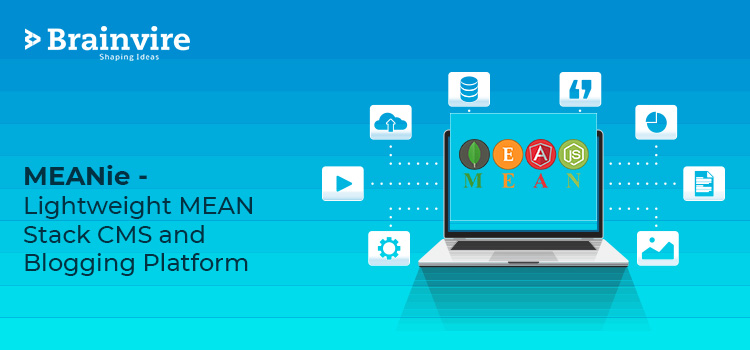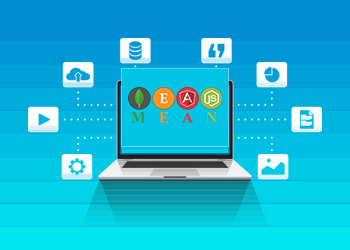
MEANie is a new open-source, custom CMS (Content Management System) and blogging platform built with MEAN stack.
This Blog application was designed for developers looking for a solution that extends easily and is customizable.
Before we dive more deeply into MEANie, let’s discuss a little bit about a MEAN stack.
MEAN stands for MongoDB, Express, AngularJS, and Node.js. It is a mix of a NoSQL database, MongoDB, with a few JavaScript web application systems, specifically Express.js and Angular.js. These keep running on Node.js. The MEAN stack has many benefits and it is also cost-effective.
Apart from this, MEAN Stack is a perfect technology for a platform for eCommerce. It is a highly recommended choice for creating an eCommerce platform when it comes to a personalized solution. It is JavaScript-based and is highly result-oriented.
Features
Production-Ready – Capable of meeting user’s requirements. It is usable, reliable, and is available to use.
Lightweight – A lightweight program that is intended to have a limited memory footprint (RAM use) and low CPU use, with low machine resource use overall
Secured – In their environment, the systems and resources remain protected and attacks are detected and removed.
Server-Side Rendering – Sends the client a completely rendered page; the JavaScript package of the client takes over and enables the SPA system to run.
Single Page Application -Each time the user interacts with the program, it loads faster without reaching the server.
Standalone – It can run easily on the local device.
Easy Installation – Setup Node.js + MongoDB Production Server on Ubuntu 18.04 – Ubuntu 19.04.
Mean Stack Compatibility – Platform compatible only with Angular 1 not with any other angular version
Easy deployment MEANie to production with Digital Ocean.
MEANie Structure
The MEANie structure consists of four major sub-applications:
CMS/Admin System
A content management system(CMS) is a secure software application or a collection of interconnected programs that enables you to create and manage digital content on your website. This application manages the content displayed on the front-end website. Without having to know HTML, CSS, or other coding languages, a CMS grants you the ability to upload, edit and delete content from a website.
In MEANie’s CMS application the code is written using AngularJS and Bootstrap. Most of the coding conventions obey the best practice guidelines from the style guide of Angular 1. CMS by default contains sections where developers can manage their blog posts, webpages, and 301 redirects. These sections can be customized to any content type that suits them best for the front end of the website.
Public Website / Blog
This section is the face of the website. The front end of the website or blog that’s visible to the public. The default front end or the web front is also customizable; it can be replaced by any website that a developer wants to build or is planning to build.
The front end in MEANie is written in a mixture of AngularJS and server-side rendered Javascript templates. The idea behind building it this way was to get SPA’s (Single Page Application) response along with AngularJS plus and the SEO benefits of server-side rendered applications.
Install Page
This is used to create an admin login for CMS access. This page runs once when the first time any user accesses the application.
Login Page
A standalone login page for the CMS to access. It is different from the AngularJS CMS. Which enables to keep the CMS front-end files secured and available to authorized individuals.
Customizing and Developing with MEANie
Due to MEANie’s feature-complete and flexible nature, it is easily customizable. Which makes web developers’ jobs less cumbersome. It is organized in two separate folders server-side and client-side.
The blog front end code is written in angular js and is located in the “\client\blog” folder and the CMS front end code is present inside the “\client\admin” folder. The server-side code consists of various controllers, services, and helpers. With these controllers, users can define routes, services that are mainly used to handle all database communications and business logic. Whereas, helpers are rendering HTML elements in Razor files.
And for performing customization activities such as remove or replace features from the tool developers can edit in any code editor preferred by them.
Other CMS built using MEAN stack
Many companies offer different stack development services. Many CMS platforms are already built on MEAN stack such as :
- Biz Site Genie – Built on meanjs, an open-source project that offers an admin interface for creating and organizing content without writing code. Support for uploading spreadsheets is in place. For various parts of your application, you can handle permissions. To build dashboards and maps, it also has a zero-code GUI. By requesting it on the website, you can host it on your server or obtain a hosted example.
- Keystone – This is an open-source platform for Node.js to create database-driven websites, software, and APIs. Driven by Express and MongoDB. At Keystone Demo, there is an online demo available.
Keystone configures express – the node.js web server – for you and uses Mongoose, the leading ODM package, to connect to your MongoDB database. Rubedo – Rubedo is not a MEAN stack but uses MongoDB, AngularJS, Sencha’s ExtJS, Zen 2 Framework.
Related Articles
-
Node.js Architecture: Effectively Build Spectrum of Scalable Apps
Talking About Node.js Architecture: Effectively Build Spectrum of Scalable Apps , It doesn’t make any sense that we select ‘The Best’ development framework for our business requirement. Rather, we go
-
Why is MEAN Stack a cut above other technological Frameworks?
The IT industry is a dynamic arena; therefore, it is a paramount for businesses to be innovative and responsive with their web development. To grow globally, Web developers need to
-
Why AngularJS Is Best Fit For Responsive Web App Development?
Talking About Why AngularJS Is Best Fit For Responsive Web App Development? In order to ease the complex programming structure, web developers switched to the modern jQuery as it is



